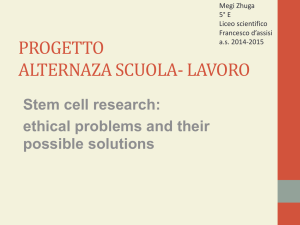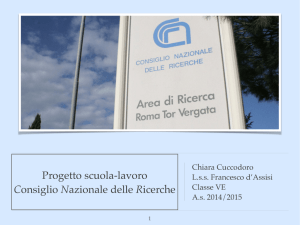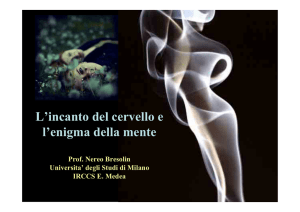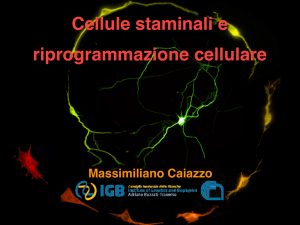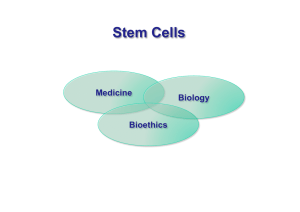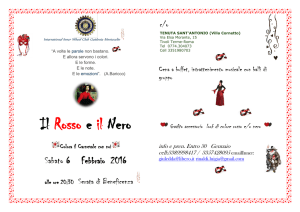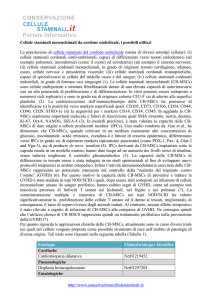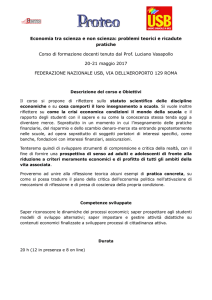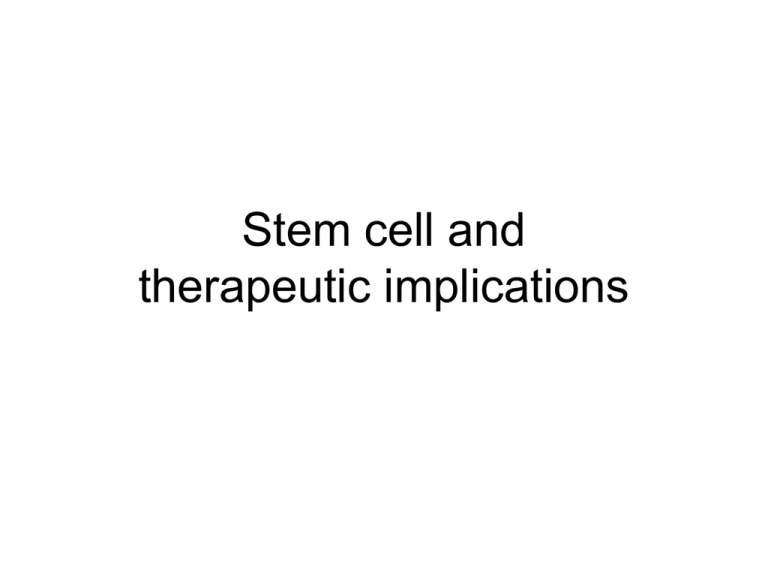
Stem cell and
therapeutic implications
A life story…
Cellula capace di dare origine
a tutte le popolazioni cellulari
di uno o più tessuti.
What is a stem cell?
stem cell
SELF-RENEWAL
(copying)
stem cell
DIFFERENTIATION
(specializing)
specialized cell
e.g. muscle cell, nerve cell
Why self-renew AND differentiate?
1 stem cell
1 stem cell
Self renewal - maintains
the stem cell pool
4 specialized cells
Differentiation - replaces dead or damaged
cells throughout your life
Cellula staminale
• Cellula capace di dare origine a tutte le
popolazioni cellulari di uno o più tessuti.
• Normalmente, da cellule staminali
nascono sia nuove cellule staminali, sia
cellule capaci di dividersi rapidamente, ma
probabilmente solo un numero finito di
volte, che cominciano anche il processo di
differenziamento:
queste ultime costituiscono il cosiddetto
compartimento di espansione del tessuto.
Where are stem cells found?
embryonic stem cells
blastocyst - a very early
embryo
tissue stem cells
fetus, baby and throughout life
Totipotente
Pluripotente
Multipotente
Cellule Staminali Pluripotenti indotte iPSC
Cellule Staminali del cancro
Cellula staminale totipotente
Cellula capace di dare origine a tutte le
popolazioni cellulari dell'organismo
Tali sono le cellule all'interno della morula o della blastocisti, cioè
di stadi precoci dello sviluppo embrionale (prima settimana di
sviluppo dell'uomo).
Le cellule embrionali staminali (in sigla ES da
Embryonic Stem cell), hanno come caratteristica
principale l'elevata capacità di differenziarsi in
qualsiasi altro tipo cellulare.
Inoltre è possibile mantenerle in coltura per un
lungo periodo di tempo.
Cellula staminale pluripotente
Cellula capace di dare origine a più
popolazioni cellulari, in generale a
tutte quelle di un tessuto
ad esempio, tutte quelle del midollo osseo, o tutte
quelle dell'epitelio mucoso intestinale
Cellula staminale del funicolo ombelicale:
Cellula staminale, presumibilmente pluripotente e
capace di dare origine a varie popolazioni delle
cellule del sangue, che è presente in circolo durante
la vita fetale e quindi anche nel sangue del funicolo
ombelicale; quest'ultimo può essere prelevato alla
nascita senza alcun trauma per l'organismo.
Tissue stem cells:
Neural stem cells (NSCs)
Neurons
Interneurons
Oligodendrocytes
NSC
Type 2 Astrocytes
Type 1 Astrocytes
brain
committed progenitors
specialized cells
Cellule Staminali nell’adulto
surface of the eye
skin
testicles
brain
breast
intestines (gut)
bone marrow
muscles
Le cellule staminali adulte sono purtroppo di difficile
reperibilità, poiché numericamente molto scarse;
non possono essere coltivate a lungo poiché, dopo
alcune divisioni cellulari, tendono a perdere le
caratteristiche di pluripotenzialità.
Le cellule staminàli embrionali, invece, possono essere
mantenute in coltura per moltissimi cicli di divisione,
addirittura per più di dieci anni, senza perdere di
pluripótenzialità.
Cloning
There are two VERY different types of cloning:
Reproductive cloning
Molecular cloning
gene 1
gene 2
Use to make two identical individuals
Use to study what a gene does
Very difficult to do
Routine in the biology labs
Illegal to do on humans
Reproductive cloning
adult cell
egg
remove nucleus
and take the
rest of the cell
take the nucleus
(containing DNA)
Clone
identical to the individual
that gave the nucleus
Dolly the sheep
È chiaro che disporre di un reagente
biologico quale le cellule staminali, da
differenziare nei diversi tipi cellulari,
apre nuovi scenari terapeutici:
patologie ora poco trattabili, potrebbero
essere affrontate con maggior successo
grazie alla sostituzione dei tessuti
danneggiati.
Negli ultimi anni si è aggiunta un'altra fonte
molto promettente, basata sulla possibilità di
modificare il programma genetico delle
cellule differenziate.
Induced pluripotent stem cells (iPS cells)
‘genetic reprogramming’
= add certain genes to the cell
adult cell
induced pluripotent stem (iPS) cell
behaves like an embryonic stem cell
differentiation
culture iPS cells in the lab
Advantage: no need for embryos!
all possible types of
specialized cells
Stem cell niches
Niche
stem cell
Microenvironment around stem cells that provides
support and signals regulating self-renewal and
differentiation
Direct contact
Soluble factors
niche
Intermediate cell
Stem cell niches
The stem cell niche is a major concept in stem cell biology. Understanding
the microenvironment around stem cells is as important as understanding
stem cells themselves. The microenvironment regulates the behavior of
stem cells and thus can teach us how to control stem cells in culture.
The niche can act on a stem cell by various mechanisms:
•Direct contact between the stem cell and the niche cells
•Soluble factors released by the niche that travel to the stem cell
•Intermediate cells that ‘communicate’ between the niche and the stem cell
Scientists are still working to understand exactly how niches work, and more
is known about the niches of some kinds of stem cells than others.
Induced pluripotent stem cells (iPS cells)
genetic reprogramming
pluripotent stem cell
(iPS)
adult cell (skin)
differentiation
This selective gene expression controls the four essential processes by
which the embryo is constructed:
•
cell proliferation, producing many cells from one
•
cell specialization, creating cells with different characteristics at different
positions
•
cell interactions, coordinating the behavior of one cell with that of its
neighbors
•
cell movement, rearranging the cells to form structured tissues and
organs
Geni della pluripotenza – Fattori di trascrizione
Nanog, Oct4, Sox2
Role of SOX2 in maintaining pluripotency of human
embryonic stem cells
Genes to Cells (2010) 15, 455–469
Human embryonic stem cell (ESC) pluripotency is thought to be regulated by
several key transcription factors including OCT4, NANOG, and SOX2. Although
the functions of OCT4 and NANOG in human ESCs are well defined, that of
SOX2 has not been fully characterized. To investigate the role of SOX2, we
modulated the level of SOX2 expression in human ESCs. Reduction of SOX2
expression in human ESCs induced trophectodermal and partial endodermal
differentiation.
EMBO J. 2010 Oct 6;29(19):3236-48. Epub 2010 Aug 24.
Oct-3/4 regulates stem cell identity and cell fate decisions by modulating Wnt/βcatenin signalling.
Abu-Remaileh M, Gerson A, Farago M, Nathan G, Alkalay I, Zins Rousso S, Gur M,
Fainsod A, Bergman Y.
Department of Developmental Biology and Cancer Research, The Hebrew University
Medical School, Jerusalem, Israel.
Abstract
Although the transcriptional regulatory events triggered by Oct-3/4 are well documented,
understanding the proteomic networks that mediate the diverse functions of this POU
domain homeobox protein remains a major challenge. Here, we present genetic and
biochemical studies that suggest an unexpected novel strategy for Oct-3/4-dependent
regulation of embryogenesis and cell lineage determination. Our data suggest that Oct-3/4
specifically interacts with nuclear β-catenin and facilitates its proteasomal degradation,
resulting in the maintenance of an undifferentiated, early embryonic phenotype both in
Xenopus embryos and embryonic stem (ES) cells. Our data also show that Oct-3/4mediated control of β-catenin stability has an important function in regulating ES cell
motility. Down-regulation of Oct-3/4 increases β-catenin protein levels, enhancing Wnt
signalling and initiating invasive cellular activity characteristic of epithelial-mesenchymal
transition. Our data suggest a novel mode of regulation by which a delicate balance
between β-catenin, Tcf3 and Oct-3/4 regulates maintenance of stem cell identity. Altering
the balance between these proteins can direct cell fate decisions and differentiation.
Models of cellular reprogramming.
Stadtfeld M , Hochedlinger K Genes Dev. 2010;24:22392263
©2010 by Cold Spring Harbor Laboratory Press
Putative role of reprogramming factors during iPSC formation.
Stadtfeld M , Hochedlinger K Genes Dev. 2010;24:22392263
©2010 by Cold Spring Harbor Laboratory Press
Spinal muscular atrophy refers to
a group of autosomal recessive
neuromuscular disorders
characterized by degeneration of
the anterior horn cells of the
spinal cord, leading to
symmetrical muscle weakness
and atrophy. SMA is the second
most common lethal, autosomal
recessive disease in Caucasians
after cystic fibrosis(Wirth,
2000).
Potential applications of iPSCs.
Stadtfeld M , Hochedlinger K Genes Dev. 2010;24:22392263
©2010 by Cold Spring Harbor Laboratory Press
spinal muscular atrophy type I (SMA I)
is caused by mutation or deletion in the
copy of the SMN gene, known as SMN1
• ricostruzione del midollo spinale danneggiato
da traumi fisici
• del tessuto cardiaco dopo infarto,
• malattie infiammatorie di natura sistemica
• a quelle muscolo-scheletriche (displasia ossea,
malattie progressive delle giunture, osteogenesi imperfetta,
miopatie primitive)
•
•
•
•
malattie degenerative della retina,
della cornea
dell'apparato uditivo,
malattie degenerative del sistema nervoso
(Alzheimer, Parkinson, malattia di Huntington, sclerosi laterale
amiotrofica)
Applicazioni terapeutiche delle cellule staminali
· Trapianto autologo di cellule staminali
emopoietiche
· Trapianto allogenico di cellule staminali
· Trapianto allogenico di cellule staminali
emopoietiche del cordone ombelicale
· Trapianto di cellule staminali cutanee: cellule
staminali coltivate in vitro utilizzabili solo per pazienti con
patologie cutanee gravi ed ustioni
Terapia genica
con le tecniche d'Ingegneria genetica si può
correggere l'effetto prodotto da geni difettosi infatti le
cellule staminali tollerano meglio di altre cellule
l'inserimento di geni dall'esterno.
Questa tecnica potrebbe permettere la correzione di
difetti genetici nelle prime fasi di sviluppo
embrionale
Rigenerazione di tessuti ed organi a partire da
cellule staminali:
E' già possibile ricostituire alcune popolazioni cellulari a
partire da cellule staminali pluripotenti del tessuto
medesimo, come avviene per le cellule del sangue
mediante il trapianto di midollo osseo;
sono allo studio progetti per far rigenerare interi tessuti
o addirittura organi,
ma va tenuto presente che in questo caso non è
sufficiente far generare una o più popolazioni
cellulari, ma va anche fatto in modo che queste
producano matrice extracellulare nella appropriata
quantità e disposizione, che assumano i rapporti
spaziali reciproci tipici del tessuto e dell'organo
maturo e, in particolare per la rigenerazione di organi,
che questi assumano la forma tridimensionale loro
propria e necessaria alla funzione, tutti punti ancora
da esplorare.
In tutti i mammiferi le prime fasi dello sviluppo
embrionale a partire dallo zigote avvengono grazie
agli RNA messaggeri (mRNA) e alle proteine di origine
materna presenti nel citoplasma dell'oocita.

